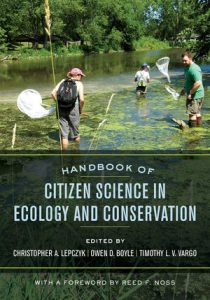 Handbook of Citizen Science in Ecology and Conservation, which will be released in May, is the first practical and comprehensive manual for creating, implementing, or improving natural science research and monitoring projects that involve collaboration between scientists and the public. As citizen science projects become increasingly common, project leaders are seeking information on concrete best practices for planning and implementing projects—practices that allow them to guide and gauge success while also ensuring the collection of high-quality data and rewarding experiences for volunteers. (Second Century Stewardship citizen science workshops are designed to address this need.)
Handbook of Citizen Science in Ecology and Conservation, which will be released in May, is the first practical and comprehensive manual for creating, implementing, or improving natural science research and monitoring projects that involve collaboration between scientists and the public. As citizen science projects become increasingly common, project leaders are seeking information on concrete best practices for planning and implementing projects—practices that allow them to guide and gauge success while also ensuring the collection of high-quality data and rewarding experiences for volunteers. (Second Century Stewardship citizen science workshops are designed to address this need.)
Acadia National Park science coordinator Abe Miller-Rushing and Schoodic Institute science information specialist Emma Albee are authors on a chapter about the history of citizen science in ecology and conservation. Historically, they write, much science was conducted by untrained volunteers, yet many of these ‘amateurs’ were experts in their fields, conducting research indistinguishable, and sometimes superior to, that done by most professional scientists at the time.
This is the definitive reference guide for anyone interested in starting or improving a citizen science project with ecological or conservation applications, from professors and graduate students to agency staff and nongovernmental organizations.